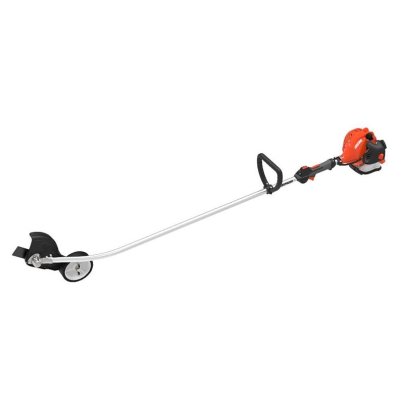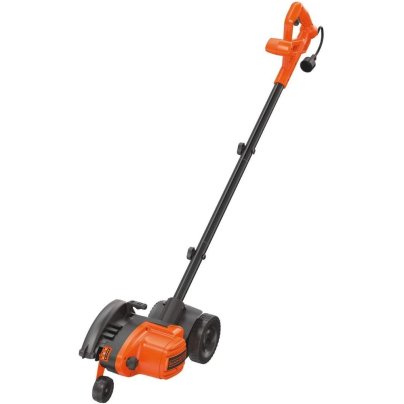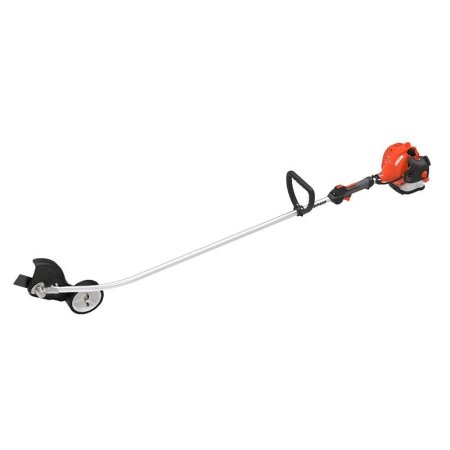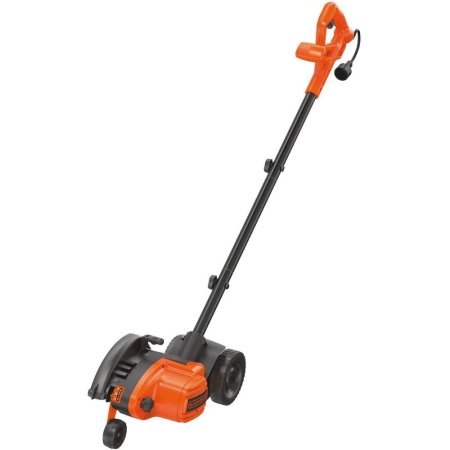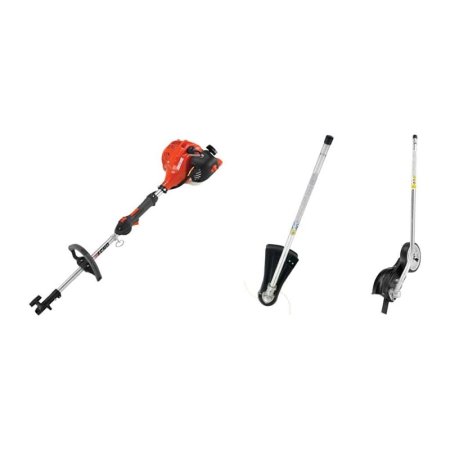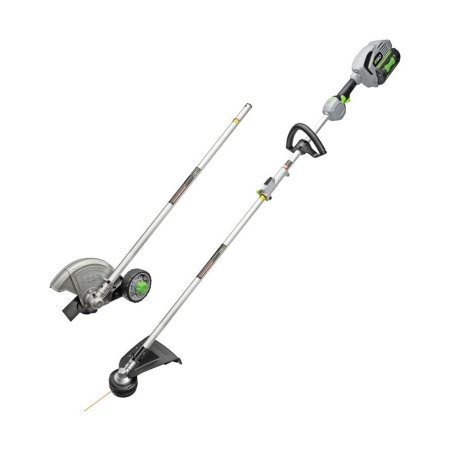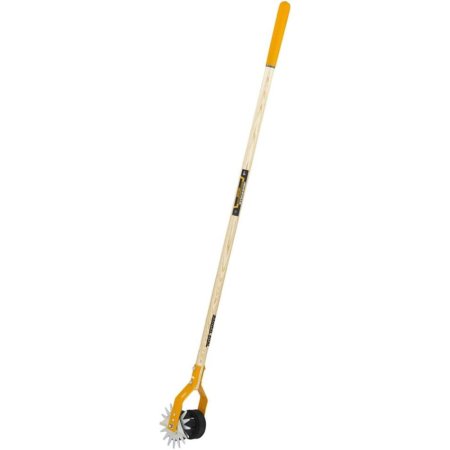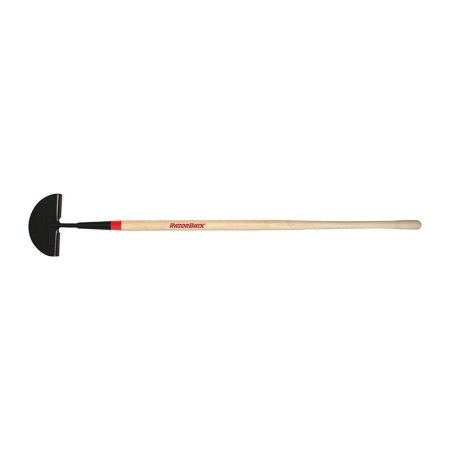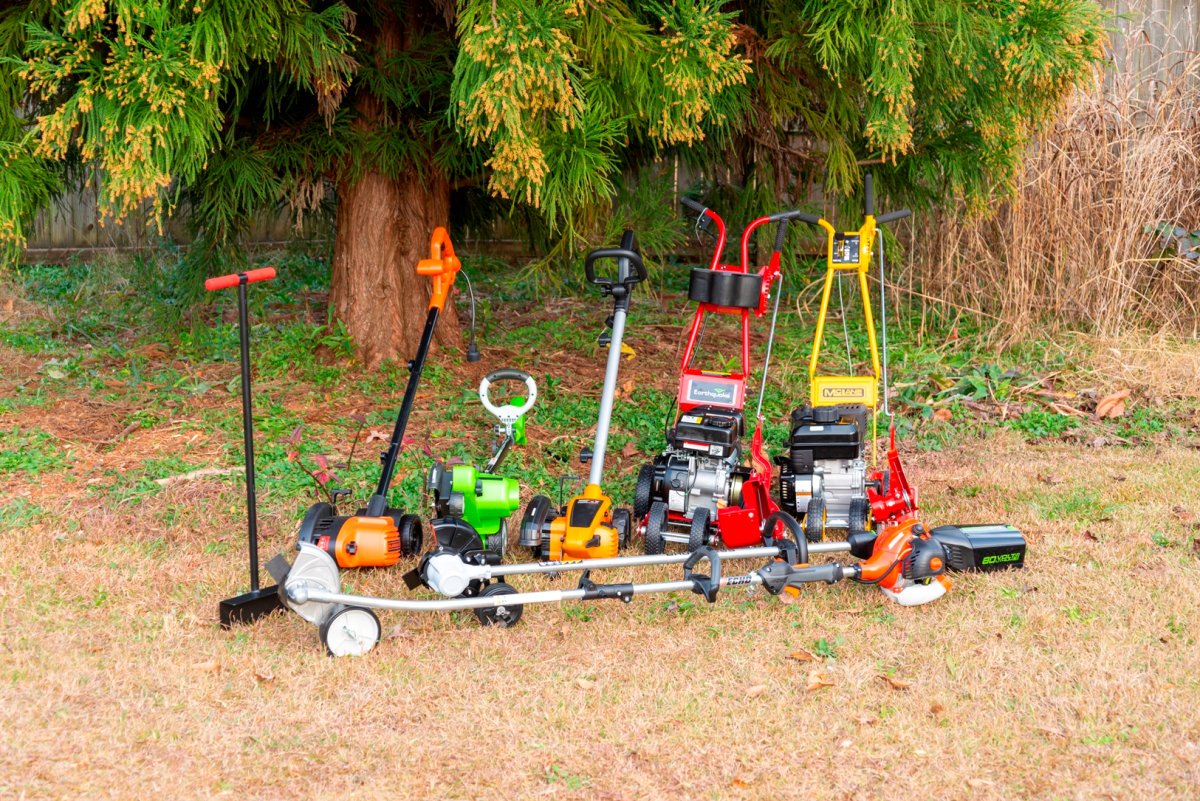
We may earn revenue from the products available on this page and participate in affiliate programs. Learn More ›
Regardless of the size, style, or complexity of your landscape, a lawn edger will help you keep it looking its best. Lawn edgers are steel-bladed tools used to create crisp, semipermanent grass edge lines along driveways, sidewalks, curbs, and landscape beds. These outdoor tools come in a variety of types and sizes, including manual, handheld gas- and electric-powered, and large walk-behind models.
Selecting the right edging tool as part of your lawn care quiver depends on your property size and personal preferences. To help you make your choice, we tested 16 lawn edgers to discover their pros and cons. Based on our tests, we think many homeowners will be happy with the Echo PE-225 Curved-Shaft Gas Lawn Edger for its precise performance, maneuverability, and value. In this review roundup, you’ll find the performance details on this and other picks that made our list so you can find the best lawn edger for your yard.
- BEST OVERALL: Echo PE-225 Curved-Shaft Gas Lawn Edger
↓ Jump to Review - BEST BANG FOR THE BUCK: Black+Decker 2-in-1 String Trimmer/Edger & Trencher
↓ Jump to Review - BEST GAS COMBO: Echo PAS-225VP Gas String Trimmer & Edger Kit
↓ Jump to Review - BEST CORDLESS COMBO: Ego Power+ Multi-Head Trimmer & Edger Combo Kit
↓ Jump to Review - BEST BATTERY-POWERED: Greenworks 60V 8″ Cordless Edger w/ Battery & Charger
↓ Jump to Review - BEST MANUAL: True Temper Dual-Wheel Rotary Edger
↓ Jump to Review - BEST FOR LANDSCAPE BEDS: Razor-Back Half-Moon Turf Edger With Wood Handle
↓ Jump to Review
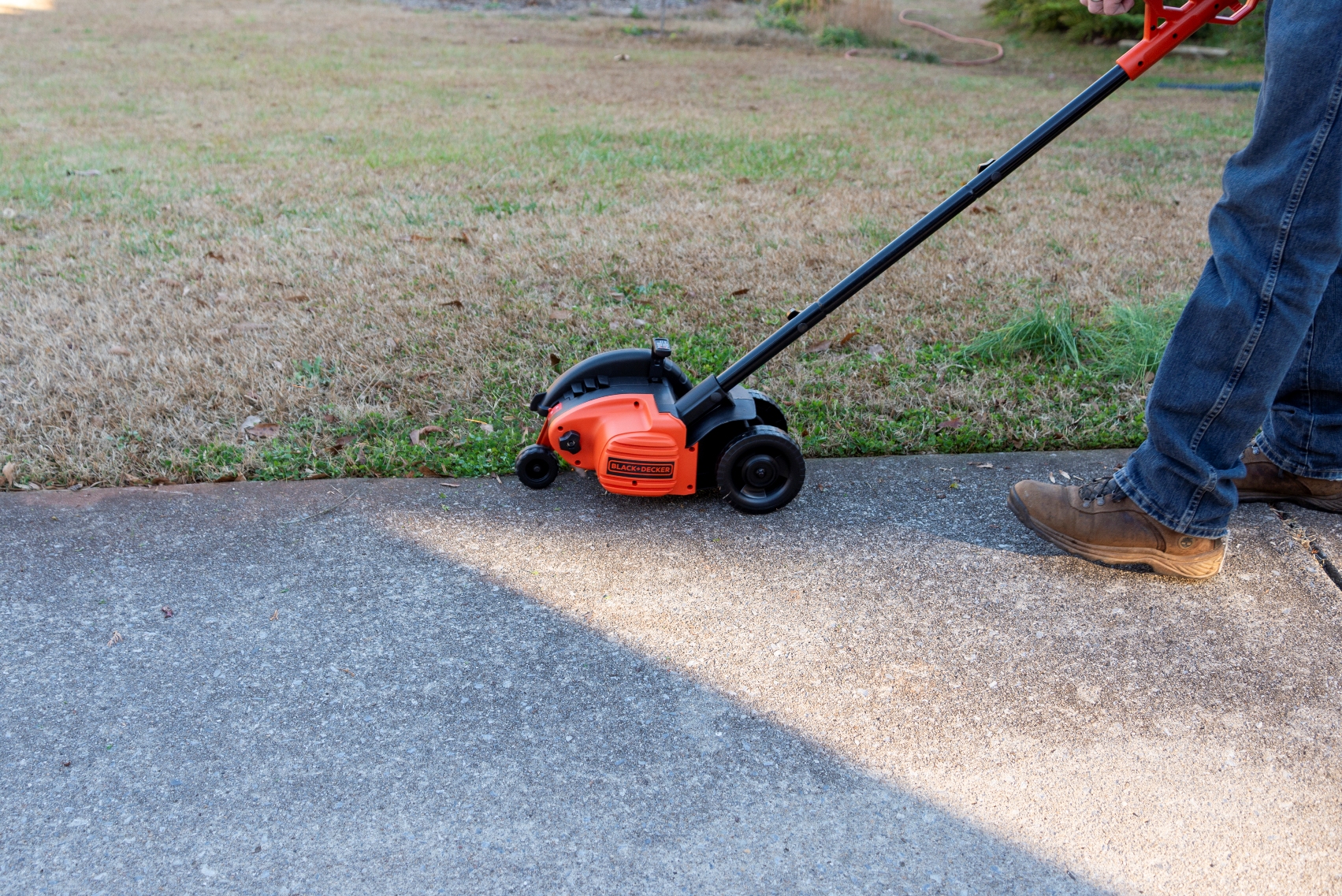
Lawn Edgers Comparison Chart
| Product | Type | Power Source | Weight |
|---|---|---|---|
| Echo PE-225 Curved-Shaft Gas Lawn Edger | Handheld | 21.2 cc 2-cycle gas engine | 13.1 pounds |
| Black+Decker 2-in-1 String Trimmer/Edger & Trencher | Handheld | Corded 12-amp electric motor | 14.4 pounds |
| Echo PAS-225VP Gas String Trimmer & Edger Kit | Handheld | 21.2cc 2-cycle gas engine | 16.2 pounds |
| Ego Power+ Multi-Head Trimmer & Edger Combo Kit | Handheld | 56V 5.0 Ah battery | 15.94 pounds |
| Greenworks 60V 8″ Cordless Edger w/ Battery & Charger | Handheld | 60V 2.0 Ah battery | 13.5 pounds |
| True Temper Dual-Wheel Rotary Edger | Handheld rotary edger | Manual | 3.9 pounds |
| Razor-Back Half-Moon Turf Edger With Wood Handle | Handheld half-moon edger | Manual | 3.8 pounds |
Our Top Picks
After researching and testing dozens of possible options for inclusion in our list of the best lawn edgers, the products that made the cut did so for their exceptional quality and performance. To be included, each garden edger had to pass our hands-on tests evaluating features, power, ease of use, safety, and value for money. Check out our reviews below for details on what we liked and didn’t.
Best Overall
Echo PE-225 Curved-Shaft Gas Lawn Edger
What We Like
- Excellent precision and maneuverability
- Professional-grade 2-cycle engine
- Molded open-face debris shield
- Easy height adjustment
What We Don’t Like
- Requires 2-cycle fuel
Product Specs
- Type: Handheld
- Power source: 21.2-cubic-centimeter (cc) 2-cycle gas engine
- Weight: 13.1 pounds
Our Ratings: Ease of Use 5/5; Performance 5/5; Maneuverability 4.5/5; Durability 5/5; Value 5/5
Detailing the lawn with precision calls for specialized equipment like the Echo PE-225. This gas edger for lawn maintenance delivers pro-quality results without the extra weight and expense of pro-grade equipment. It’s powered by a 21.2cc high-output 2-stroke cycle engine that uses Echo’s i-30 spring-assisted starting system to reduce pull-start effort. It features a durable molded open-face blade shield to prevent debris buildup and captive wheel-mount hardware for easy height adjustment.
This grass edger comes with enough 2-cycle oil to mix with 1 gallon of gas. During testing, the 12.8-ounce fuel tank on this garden edging tool delivered a runtime of 1.5 hours—ideal for our large suburban lot’s long driveway, patio, walkout basement slab, and numerous landscape beds. That said, the potential for engine damage from stale fuel is real. Those with only a limited amount of lawn edging will want to consider using a fuel stabilizer to protect the engine from gum and varnish buildup.
Overall, the PE-225 edger for lawn care did a respectable job digging new edges. Its 2-cycle engine produced higher blade revolutions per minute and lower torque than the 4-cycle walk-behind edger we tested. This resulted in faster, cleaner cuts for routine maintenance but less power for digging through compacted soil and roots. In terms of adaptability and top-end user comfort, it was our favorite of the group.
What our tester says: “The curved-shaft design of this gas edger makes it easy to maneuver along curbs, driveways, patios, and landscape beds. That curve, plus the fact that it only weighs about 13 pounds, made it one of the most efficient and comfortable edgers we tested.”—Mark Wolfe, Product Reviews tester and writer
Get the Echo PE-225 lawn edger at The Home Depot.
Best Bang for the Buck
Black+Decker 2-in-1 String Trimmer/Edger & Trencher
What We Like
- Easy to maneuver, lift, and store
- Powerful electric edger for thick plantlife
- Adjustable handle height
What We Don’t Like
- Limited range due to corded motor
- Better for maintenance than creating new edges
Product Specs
- Type: Handheld
- Power source: Corded 12-amp electric motor
- Weight: 14.4 pounds
Our Ratings: Ease of Use 5/5; Performance 4.5/5; Maneuverability 4/5; Durability 4.5/5; Value 5/5
The plug-and-go Black+Decker corded edger serves not only as an edger but also as a trench digger. Its 12-amp electric engine produces no emissions yet provides enough power to aid in installing outdoor lighting and fencing or planting bushes and trees. You can set this lawn edger with blade to three possible cutting depths, with a maximum depth of 3.75 inches.
As an added safety feature, this edge trimmer includes a built-in cord-retention system that keeps the extension cord in place to prevent tripping. It weighs just 14.4 pounds and has an edging guide that helps you make clean cuts around hard surfaces like patios, walkways, and driveways. In our tests, we were especially impressed with how this lawn edger tool tracked around tight landscape bed curves and straightaways along paved edges, slicing easily through grass foliage and tough surface roots for a clean edge. If you need something heavy duty for a task like digging into clay for bed-edge renovation, however, it might be a bit undersized.
Get the Black+Decker lawn edger at Amazon, The Home Depot, Walmart, or Black+Decker.
Best Gas Combo
Echo PAS-225VP Gas String Trimmer & Edger Kit
What We Like
- Multi-head design saves on storage space
- Quick and easy attachment changes
- Powerful edger cuts clean and deep
- Requires less effort to start than comparable options
What We Don’t Like
- Heavy for extended use
- Requires mixed 2-cycle oil and gas
Product Specs
- Type: Handheld
- Power source: 21.2cc 2-cycle gas engine
- Weight: 16.2 pounds
Our Ratings: Ease of Use 5/5; Performance 5/5; Maneuverability 4/5; Durability 5/5; Value 4.7/5
The 21.2-cc Echo PAS-225 power head drives more than a dozen different lawn care tool attachments to keep your yard looking great without filling your garage with multiple gas engines. The kit includes the power head, a curved shaft edger with a 9-inch square-tipped blade, and a straight shaft string trimmer. Available add-on attachments include hedge shear, pole saw, brush cutter, cultivator, bed redefiner, sweeper, and rock sweeper. Add a lawn mower and a leaf blower, and you’ll be well on your way to maintaining a great-looking lawn.
During testing, we really appreciated the versatility of the Echo PAS system. The tool attachments swap out quickly and easily with just a spring pin and tension screw handle. Both the gas string trimmer and the edger work smoothly and efficiently, and the powerhead delivers nearly as robust a performance as a professional edger. The 9-inch edger blade has no difficulty penetrating clay soil while trenching for bed renovation, and it trims crisp, clean edges along pavement. The clog-resistant open-faced metal safety shield moves well around uneven soil and taller grass, and the adjustable curb wheel is customizable for maximum comfort. When not in use, the included S-hook hanger helps keep attachments organized.
Get the Echo PAS-225VP lawn edger kit at Amazon or The Home Depot.
Best Cordless Combo
Ego Power+ Multi-Head Trimmer & Edger Combo Kit
What We Like
- As much power as a 2-cycle gas edger
- Includes powerhead, string trimmer, and lawn edger attachments
- Comes with a battery and charger
- Durable IPX4-rated weatherproof construction
What We Don’t Like
- Heavier than other battery-powered edgers
Product Specs
- Type: Handheld
- Power source: 56-volt (V) 5.0-amp-hour (Ah) battery
- Weight: 15.94 pounds
Our Ratings: Ease of Use 5/5; Performance 4.5/5; Maneuverability 4/5; Durability 5/5; Value 4.7/5
Ego Power+ offers a full range of 56-volt cordless lawn care equipment with power equivalent to gas. Its clean, quiet multi-head string trimmer and edger kit is the best battery trimmer–edger combo we tested and a nice alternative to our favorite gas-powered edger combo. The powerhead works with all Ego Power+ lawn care attachments, and the included edger attachment uses an 8-inch rectangular steel blade, just like a handheld gas edger. The string trimmer attachment comes prestrung with pro-grade 0.095-inch trimmer line. The kit also includes a 56-volt 5-amp-hour battery and charger.
In our yard, this edger lawn tool produced the best combination of torque and blade speed of any electric edger we tested—at least much as our top gas pick. It did an equally excellent job creating new edges as it did doing edge maintenance. The motor remained strong and resisted bogging, even in dry, compacted clay-based soil. The straight shaft allowed easy passage in tight spaces, but it also placed us in the direct path of flying debris, of which there was plenty. At almost 16 pounds, this was also one of the heaviest models we tested.
Get the Ego Power+ lawn edger combo at Amazon, Lowe’s, Ace Hardware, or Walmart.
Best Battery-Powered
Greenworks 60V 8" Cordless Edger w/ Battery & Charger
What We Like
- Lightweight battery-powered lawn edger
- Cuts up to 3 inches deep
- Adjustable guide wheel reduces user fatigue
- Quick recharge time
What We Don’t Like
- Less torque than some other models we tested
Product Specs
- Type: Handheld
- Power source: 60V 2.0 Ah battery
- Weight: 13.5 pounds
Our Ratings: Ease of Use 5/5; Performance 4.5/5; Maneuverability 5/5; Durability 4/5; Value 4.3/5
The Greenworks battery lawn edger offers the power of a gas stick edger with the convenience of a 60-volt cordless electric. This lightweight steel and plastic edger for lawn care features an 8-inch rectangular steel blade that cuts crisp pro-style edges up to 3 inches below the soil line. The kit includes a 60-volt 2-amp-hour battery and charger that provide up to 1 hour of runtime and a quick 50-minute recharge.
The Greenworks 60V cordless lawn edger was one of the lightest of all edgers we tested, and it delivered excellent results. For brand-new edges, we had to work a little slower to reach and maintain the maximum depth, but we also noted that it didn’t fling debris as badly as the more powerful models. While maintaining established edges, there was no performance lag between our most powerful gas model and this one.
Get the Greenworks 60V lawn edger at Amazon or Walmart.
Best Manual
True Temper Dual-Wheel Rotary Edger
What We Like
- Tried-and-true driveway and sidewalk edger
- Self-sharpening serrated blades
- 54-inch hardwood handle with cushioned grip
What We Don’t Like
- Slow-going compared to powered lawn edgers
- Better for maintaining edges than starting them
Product Specs
- Type: Handheld rotary edger
- Power source: Manual
- Weight: 3.9 pounds
Our Ratings: Ease of Use 4/5; Performance 4.5/5; Maneuverability 4.5/5; Durability 5/5; Value 5/5
For smaller properties, it sometimes makes sense to forego gas and electric lawn care equipment by choosing quality manual gardening tools. True Temper’s rotary edger features a time-tested dual-wheel design that cuts cleanly through grass and roots, creating crisp edges along driveways, patios, and sidewalks. Its two-way self-sharpening blade ensures efficient trimming, while the rubber-treaded wheels and 54-inch hardwood handle with a padded grip provide excellent control and comfort. If you want that manicured look without the noise and emissions of power tools, this could be the right tool for you.
In our tests, the True Temper dual-wheel rotary edger did a fine job along the driveway, patio, and walkout basement pad. It was less effective along the curbless street gutter due to the rough edge of the concrete, and it was not really workable for the areas where our lawn meets our landscape beds. Where it worked, however, it worked well. Using the tool took more time than a powered edger, but it required a lot less physical effort than you might imagine. You definitely don’t need to be super fit to use it.
What our tester says: “Admittedly, by the time we tested this edger, the lawn edges were well defined and only needed routine maintenance. Still, we were pretty impressed with the fact that it only took about 5 minutes to edge both sides of a 70-foot-long driveway perfectly. “—Mark Wolfe, Product Reviews tester and writer
Get the True Temper lawn edger at Amazon.
Best for Landscape Beds
Razor-Back Half-Moon Turf Edger With Wood Handle
What We Like
- 48-inch durable hardwood handle
- Produces crisp curved and straight edges
- Forward-turned step provides secure foot placement
- Heavy-gauge steel blade works in any type of soil, including rocky areas
What We Don’t Like
- Takes longer than gas- or electric-powered tools
Product Specs
- Type: Handheld half-moon edger
- Power source: Manual
- Weight: 3.8 pounds
Our Ratings: Ease of Use 4.5/5; Performance 5/5; Maneuverability 5/5; Durability 5/5; Value 4.5/5
When it comes to manual tools, blade specialization is very helpful. The Razor-Back half-moon edger, or step edger, features a heavy-duty steel blade shaped like a semicircular garden spade. Measuring 9.1 inches wide by 1.5 inches deep, the sharpened blade ensures precise cuts, while forward-turned top edges provide secure footing. Paired with a sturdy 48-inch hardwood handle, it’s designed to create natural, uniform edges where the lawn meets landscape beds.
In our tests, the Razor-Back half-moon edger was excellent for rejuvenating landscape beds and redefining overgrown edges. It excelled at creating new edge lines and restoring neglected ones but wasn’t ideal for routine maintenance, where a faster blade is needed to cut grass roots and stems cleanly. For that reason, it pairs well with the True Temper rotary edger, which is better suited for ongoing upkeep.
Get the Razor-Back lawn edger at Ace Hardware or The Home Depot.
Jump to Our Top Picks
How We Tested the Best Lawn Edgers
| Testing Stats | |
| Products tested | 19 |
| Time spent testing | 24 hours |
| Tests performed | 5 |
| Price range | $35 to $450 |
We tested these tools in real-world scenarios, including basic grass edge maintenance along pavement, refining soft edges along landscape beds, and cutting into new ground for bed definition. Our testing yard provided a diverse mix of conditions—a driveway edge that needed simple upkeep, a neglected curb with overgrowth, and landscape beds ranging from well-maintained to poorly defined.
To make our list, these edgers had to function well in every location based on the projects for which they are intended. For instance, plug-in electric edgers for lawns are designed for maintaining existing edges in small landscapes and are not expected to dig into unbroken soil for extended periods. On the other hand, gas-powered walk-behind models are intended for both detailed trim work and powerful groundbreaking during long hours of work.
| Product | Ease of use | Performance | Maneuverability | Durability | Value |
| Echo PE-225 Curved-Shaft Gas Lawn Edger | 5 | 5 | 4.5 | 5 | 5 |
| Black+Decker 2-in-1 String Trimmer/Edger & Trencher | 5 | 4.5 | 4 | 4.5 | 5 |
| Echo PAS-225VP Gas String Trimmer & Edger Kit | 5 | 5 | 4 | 5 | 4.7 |
| Ego Power+ Multi-Head Trimmer & Edger Combo Kit | 5 | 4.5 | 4 | 5 | 4.7 |
| Greenworks 60V 8″ Cordless Edger w/ Battery & Charger | 5 | 4.5 | 5 | 4 | 4.3 |
| True Temper Dual-Wheel Rotary Edger | 4 | 4.5 | 4.5 | 5 | 5 |
| Razor-Back Half-Moon Turf Edger With Wood Handle | 4.5 | 5 | 5 | 5 | 4.5 |
What to Consider When Choosing a Lawn Edger
Don’t make a hasty decision about the best edger for lawn care in your garden or yard. Consider key factors such as power, blade type, cutting width and depth, and built-in safety features to ensure you select the right lawn edging tool for your needs.
Types of Lawn Edgers
There are many options to choose from when deciding on the best lawn edgers to keep the yard well maintained and weed-free. Edgers for lawns typically fall into three categories based on the power source: manual, electric, and gas.
Manual
Instead of relying on an electric- or gas-powered motor to get the job done, a manual edger tool for lawn care is completely powered by the user.
- Rotary edgers have a long wooden shaft that attaches to a cutting wheel. The tool looks like a pole with a spiked wheel on the end. They work by applying pressure to the cutting wheel as you roll it along the edge of the lawn to cut through the overextended turf.
- Spade edgers resemble a shallow spade with a sharpened edge. To use, line up the bottom of the spade edger with the overextended turf and step down on the flat surface at the top of the blade to increase the force to cut through the sod.
- Shear edgers are handheld tools that are rarely used. These tools are intended for cleaning up small pieces of sod or making cuts in narrow corners where other edging tools cannot reach. However, they aren’t suitable for edging the entire yard.
Motorized
If manually edging the lawn seems daunting or you don’t want to limit your war on weeds to what you can physically endure, choosing a motorized lawn edger will be best. There are two main kinds of motorized lawn edgers: ones with an electric motor and those powered by a gas engine.
- Electric lawn edgers are usually more budget-friendly and suitable for small yards. Available in both corded and cordless varieties, they may not be as powerful as gas models. However, battery-powered tools are getting more impressive each year, and there’s even a 56-volt electric model in this guide. Corded varieties often supply 10 to 12 amps of power, though they are slightly less mobile unless paired with an extension cord.
- Gas-powered lawn edgers, available with a 2- or 4-cycle engine, boast considerable power and are better suited for larger yards. While 2-cycle engines are more common, users must replenish fuel and oil. They are less environmentally friendly than 4-cycle engines, which run clean but cost and weigh more.
Power
When choosing the best lawn edger for your yard, it’s important to understand its power potential. Gas and electric options can provide comparable power output, but manual lawn edgers depend on your exertion.
- Gas lawn edgers measure power output in horsepower (hp) and engine size in cubic centimeters (cc). Typically, the higher the hp and cc, the more powerful the engine and the more significant the difference in efficiency and cost.
- Electric- and battery-powered lawn edgers rely on electric engines powered by a direct electrical connection or attached battery. These devices measure power output in amps and voltage with higher voltage and amp ratings indicating a more powerful electrical engine.
Blade Type
A straight, no-frills blade can handle simple yards just fine, but an edger that offers multiple positions and angle settings may be a worthwhile investment if your property has a lot of flower beds and specialty features. The three main types of edger blades are as follows:
- Flat rectangular blades with plain edges are the most common among lawn edgers. They are suitable for basic edging jobs where the lawn is flush and level with the nearest hard surface (like a driveway or a sidewalk).
- Flat rectangular blades with scoop-cut edges are ideal for perimeters of more delicate landscaping features like flower beds, which might otherwise be disturbed by debris during rough cutting. These blades are also ideal when the lawn and hard surfaces are uneven.
- Star-shaped blades are useful for cutting yards with firm boundaries, like lawns that end at a wall or a sturdy fence.
If you have only a few needs to address, you may be able to purchase the desired replacement blade(s) for the edger and swap them in as necessary. This is generally easy and only adds a few minutes of transition time to yard work.
Cutting Width and Depth
The cutting width of a lawn edger can refer to the cutting width of a combined trimmer and edger tool, but it may also simply indicate the physical width of the edger. Cutting width can impact the edger’s ability to access tight corners or areas restricted by fences, decks, patios, foliage, or even the home.
However, a more important consideration is the depth of the edger, which refers to the maximum depth at which the edger blade can penetrate the ground. Typically, corded-electric, gas-powered, and battery-powered lawn edgers have a blade depth of about 2 to 6 inches. This allows the blade to plunge into the turf to cut and remove deep root systems. Manual grass edgers often have a limit of about 2 to 4 inches to the cutting depth, though this is still deep enough to cut through most root growth.
Wheel Configuration
While a lightweight manual grass edging tool moves on nothing more than the user’s guidance, the weight of an engine typically requires three or four wheels to cover a property without straining the operator. The rear wheels move the entire unit along, while a guide wheel keeps the blade aligned with the task at hand.
Some gas-powered lawn edgers offer the addition of a fourth wheel (a “curb wheel”) to help stabilize the edger when using it at a slight drop-off, such as the line where the lawn meets the street. If you opt for an electric lawn edger or don’t need to maneuver around many curbs, three wheels are likely sufficient.
Ease of Use
Using a lawn edger can be tiring, especially for those toiling away with a manual edger, but several factors can help make the work easier. These include the shaft size, the edger’s weight, and the runtime of both battery-powered and gas-powered edgers.
- The shaft of a lawn edger can vary in length and size depending on the specific tool. Some edgers have two handles to help maneuver heavy engines, while others have a single shaft to control the movement of lightweight edgers. Look for an edger that suits your height and strength to prevent overexertion while edging.
- The weight of a lawn edger can wear on the user, especially when working in a very large yard or dealing with many precision cuts in tight spaces. The additional time spent edging can cause lasting aches and pains, but switching to a lighter lawn edger can reduce muscle strain and fatigue.
- The runtime of both gas- and battery-powered lawn edgers can limit the amount of work you can complete. Gas edgers need refilling, and batteries need recharging. Keep these limitations in mind, especially when working on very large yards. Purchasing an extra battery is an easy way to increase runtime for a cordless edger.
Safety
Safety should always be a priority, especially when operating a tool that cuts through solid earth and tough root systems. Otherwise, serious injuries can occur. To stay safe while you work, look for products with built-in safety features, such as debris guards, trigger locks, and padded grips.
- Debris guards are typically positioned at the back of the edger to prevent grass, dirt, and rocks from being kicked back into your feet and legs. However, some debris can escape even with a guard, so it’s smart to wear safety glasses, long pants, and closed-toe shoes while working.
- Trigger locks help prevent accidental start-ups by keeping the edger inactive unless the lock switch is engaged. Holding the switch down unlocks the trigger, allowing the edger to operate normally.
- Padded grips on the shaft and handle of an edger help reduce vibrations. Strong and continuous vibrations can cause muscle fatigue and strain, but this padding protects your hands and makes it easier to grip and control the edger.
Additional Features
Many manufacturers offer product features beyond the basic design to help improve the lawn edger’s functionality and make the tool more appealing. These additional features can include two-in-one trimming and edging tools, adjustable auxiliary handles, and accessories.
- A two-in-one trimming and edging tool allows you to choose between trimming the grass or edging the lawn. These combined edging and trimming tools are useful for small-to-medium yards, but it may be better to invest in a separate edging tool for homes with larger yards.
- Adjustable auxiliary handles provide an additional place to grip the edger for better balance and control. Users can also slide the auxiliary handle up or down the shaft to suit their height, making use easier.
- Accessories can include a wide range of products that can be packaged together with the edger, including extension cords, extra batteries, and chargers.
FAQs
After reading the various shopping tips and factors involved in selecting a lawn edger, you may still have questions about the best depth for edging or how frequently to edge your lawn.
To maintain existing edges, simply follow along the edge of pavement with the lawn edger to keep grass neat and tidy. For existing natural edges between lawn and landscape beds, use the edger to make a thin cut all along the edge.
If you’re wondering how to edge a lawn for clean, natural landscape borders adjacent to mulched areas, first lay out neatly curved edge lines with a garden hose and cut a vertical line along the length of the hose with a half-moon edger. Alternatively, you can paint the line and follow the paint with a powered edging tool for the vertical cut. After making the vertical cut line, use a border spade to remove a wedge of soil from the landscape bed side along the length of the edge. The grass-side cut will be vertical, while the bed side cut will be beveled.
Typically, about 2 to 4 inches deep is sufficient for controlling the growth and spread of grass roots, keeping the grass from growing into the gaps in the patio or walkway.
It depends on the grass. Some grass grows and spreads very quickly, so you need to at least check the edge lines every time you mow. Most yards require edging with every two or three mows.
Whether you edge or mow first is almost entirely a matter of preference. If you choose to edge first, the mower will help clean up excess grass clippings, but it’s easier to create a straight edge at a consistent depth if you mow first.
Ease of use varies among people and products, but one of the easiest edgers to use is the Razor-Back lawn edger. Just line up the manual spade edger and push down with your foot to cut into the turf. Continue this process along the entire edge to complete the job.
A lawn edger and a string trimmer are two different tools that work together to maintain a well-groomed landscape. Lawn edgers have rigid blades that rotate vertically to cut off roots and shoots that would otherwise grow out of bounds. Many landscaping pros use the lawn edger once or twice a month to define the edges and employ the string trimmer in the interim to keep things tidy.
Meet the Tester
Mark Wolfe is a writer and product tester with a background in the nursery and landscaping industry. For more than 20 years he mowed, edged, planted, pruned, cultivated, irrigated, and renovated beautiful landscapes. Now he tests and writes reviews about the latest outdoor power equipment, hand tools, lawn care products, and other outdoor-living goods.
Additional research provided by Andréana Lefton and Timothy Dale.
